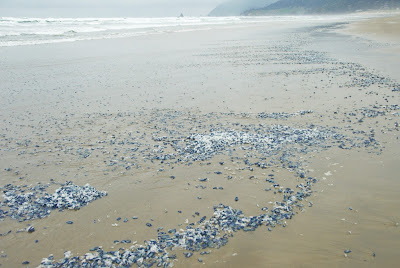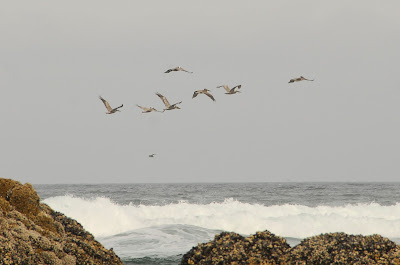I drove out from Portland the first time on a whim really, on Monday May 4th. The day was gray and threatened rain any moment; how can that already be a distant memory just six weeks later as we face a 101 degree temperature this weekend? But I digress.. So, gray and windy and not really a day for photos, but definitely a day for shorebird migration potential at the coast. I decided to head out highway 30 to Astoria and hit Fort Stevens first, then head south down 101.
I hit traffic at a dead stop just south of St. Helens. Highway 30 is just one lane in either direction with very few cross streets to provide alternate routes, and our northbound lane quickly lengthened into an endless convoy of semis and log trucks interspersed with passenger cars. The fellow in front of me got out and walked up the road a bit to converse with another truck, then came back and reported there had been a fatality and it would be at least an hour if not more. I didn't know what to do, it was too far to backtrack by going over the hills to 26, and I was determined to get through to Astoria. These are the times that Google maps online app really shines. Looked on my phone to see that a little road just a quarter mile up actually hugged the side of the hill and could possibly get me around this accident. There isn't really a breakdown lane on 30, it's too narrow, so I crept into the empty oncoming lane and scooted up to the side street. It was a single lane road that wound around the neighborhood hillside and popped out down the highway from the accident. I was jubilant to be back on the road but somehow felt guilty, as if I had cheated and wasn't honoring the levity of this highway tragedy. What are you gonna do? I hit the road.
Heading through Astoria, I took a left and climbed up the crazy hills that comprise the residential part of town, and back down the other side. Crossing Young River, I took a left on Wireless Rd, which loops through a couple miles of verdant marshy farmland. A local resident had posted sightings of big numbers of whimbrels in the fields and I had high hopes. But no luck, only a frenzy of gulls and ravens above a pile of \ industrial farm waste behind a barn. And nowhere to park and walk as it's all private land. About a mile down the road there was a pasture of some of the most beautifully marked cattle, and I wanted to stop to snap some pictures but the farmer was right there with them and I was feeling somewhat guilty as an invasive out of town birdwatcher, so kept on trucking.
I headed out to Fort Stevens to take literally a hundred pictures of a huge flock of dunlin trying to escape me up and down the beach, and a few of the resident flock of caspian terns, then headed out to the jetty to face some pretty sturdy winds. Not much flying around in that, so decided to head south to Cannon Beach and try my luck with some puffins. I have been in Oregon for 12 years now and still have not seen a puffin up close, so I was ready to end my losing streak. As I drove through Cannon Beach, I couldn't help but be reminded of parts of Cape Cod. The town caters to a similar mentality, but a brown cedar shingled version. It's a little snooty, but it's also nice to not have the boardwalk crassness to cope with. So I parked downtown and then marched across the sand towards the goal looming every larger in my binoculars: Haystack Rock, home to thousands of nesting seabirds every spring. Hundreds of circling common murres filled the sky to the north of the rock, mixed with mostly western gulls, but nary a puffin to be found. What the hell? I took a bunch of unexciting gray pictures and then the murres headed out to sea, leaving a bunch of gulls in their place. Can you say whoop dee doo? There were droves of lovely Velella velella jellyfish pushed to shore with high spring winds, and left behind with the tides. Sad little purple sailors.. By this point the rain had begun in earnest and I had to concede defeat.. This was not my day, but I would have it. Damn you puffins..
flock of dunlin
caspian terns
Velella vellela jellyfish stranded on the shore
Haystack Rock Part Deux.
After a rather sad first attempt, I decided I needed to be more methodical about my approach, narrow down those extenuating circumstances. I pulled out a calendar for May and looked at the high and low tides on all the days I could head out. I was looking for a weekday, with low tide sometime in the AM so the sun would be behind me, and some halfway decent weather. I settled on Sunday the 31st, which had a 6:52am low tide and crossed my fingers it would be too early in the day to really be overrun with tourists yet. It's about an hour and a half to Cannon Beach from Portland via Hwy 26 west, so I was pretty pleased with myself to be on the road at 5:45 that morning. Getting up at 4:30am for anything other than a trip to the airport is not a usual event in my life. I didn't grow up hunting or fishing or feeding farm animals at the crack of dawn; a begrudging appearance at my first class of the day at school was as good as it got. The road out on this Sunday was wonderfully empty except for a few surfers also racing out to greet the waves.
Got to Cannon Beach with little fanfare, and headed out the same path towards Haystack Rock. I looked for circling birds as I approached and saw nothing but a few gulls. As I got closer I saw that the members and signs of HRAP were out in full effect, as happens every low tide, bless their hearts. Haystack Rock Awareness Program comes out during any low tide that takes place in daylight hours and sets up very polite a-boards asking people to not approach the rock and to tread very carefully in and around the tidal pool/sea gardens. They're almost all retired folks, and are so nice and full of information.
One HRAP guy kindly showed me the bald eagle on the south side of the rock that had effectively scared all the seabirds away. He told me he's actually seen the eagles eat all five common species that breed on the rock during spring season: pelagic cormorant, pigeon guillemot, common murre, tufted puffin and the black oystercatcher. Do eagles eat western gulls? Probably in a pinch.. I also saw brown pelicans that day, and talked with another photographer who'd been waiting for the exchange of mated oystercatchers. Apparently every 90 minutes the mate would return to the nest and swap out with the roosting oystercatcher. Very diplomatic behavior, and just the best looking birds. Three of the birds I saw that day had an arresting red accessory, either feet or beak. Very eye-catching, or oystercatching as it would seem.
Pigeon guillemot and those Red legs
Brown pelicans
The photographer finally managed to catch the exchange on film just before he had to flee the rising tide. I missed it, as I had become obsessed with trying to catch pictures of birds in flight a bit to the north of the rock. The same bald eagle finally picked a target and set off a swarm of defensive gulls and murres, then flew back over the rock with its breakfast in its talons. After that, everything seemed to loosen up and the huge flock of murres began to circle and land on the rock for some nest checks, which lasts for maybe a half hour to 45 minutes, then they're back off to sea to sit on the water and fish the waves. I included a photo, one of many I took of common murres landing on the north side of Haystack Rock. Most true seabirds are not graceful creatures on land and walking is tough for them, but man do those landings make me laugh! But wait, mixed in with the murres and cormorants, those smaller little black football shapes with wings! Puffins! One and then another! I snapped away desperately, but alas, all the pictures are blurry of my little Sasquatches of the sky. I've included one or two anyway just to prove I did get to see some. I was able to get a few other pix of birds and tidal pool joy and more are included on my flickr site which unfortunately I can't get linked to this blog. I posted some on my facebook page if you want to navigate through there. The puffins and the murres are at Haystack Rock throughout July usually, tending their young, trying to keep them from gulls and eagles until they're old enough to fly and join their folks out at sea for the rest of the year. It's pretty fun and a great way to spend a morning at low tide. I feel so silly for not having gotten to this sooner, but I'm convinced this will happily become one of my spring traditions as long as I'm in Oregon.
Bald eagle and some pissed off western gulls
common murre landing gear hilarity
common murre
my blurry little tufted puffin
I headed north on the way home, reversing the route from my last trip, and stopped by Ft. Stevens. With the sun out, I was happy to spend some quality time with the rowdy gaggle of Caspian Terns at the lagoon beach. They hang out and fish the lagoon just before before the Columbia River meets the Pacific, and they're noisy and protective and hilarious. I hid in the tall sea grass right behind them and snapped some pictures, and then noticed I was surrounded by lady bugs crawling up and down the sea grass. I'm curious about that, they just seemed to crawl to a certain height, then turn around and back down, but hundreds of them around me were doing the same thing. I must be missing something, maybe they're marking territory somehow? I love micro moments in nature; helps provide me with perspective, both literally and figuratively. All in all, a very successful day and a great reprise to my earlier attempt. Viva the Oregon coast!
Caspian terns - my favorite crew with a call that sounds like cats in the sky
lady bug love
Oh, and you can click on any of the pictures to see them larger..















No comments:
Post a Comment